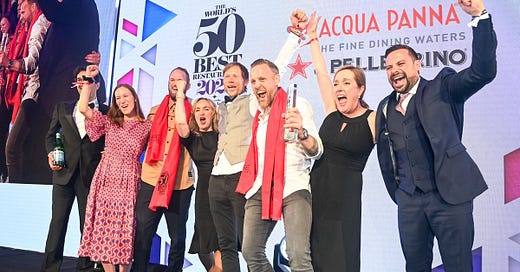The World's 50 Best Restaurants: Part 1
The Long List, the controversies, and why we should care.
This week is a big one for the international restaurant community, with the imminent unveiling of The World’s 50 Best Restaurants list. How much creedence you give to something as subjective as what is or isn’t a good restaurant is your own decision, but in the past I have been captivated by the prestige and luster of the list.
Growing up, to see luminaries like Ferran Adria or Heston Blumenthal elevated to the status of “Number One”, and all of the glitz and pageantry that went with it, felt like a coronation of a new culinary superhero. These figures were larger than life, and the gusto with which the ceremony was embraced quickly made the W50B list the first genuinely viable alternative to the Michelin Guide.
I remember vividly the excitement when it was announced that Australia, and in fact my home of Melbourne, would host the awards in 2017. The anticipation of the eyes (and mouths) that would now be cast towards Australian food gave me great hope that our local heroes would come to be lauded internationally as they are locally. I even remember going to watch the live simulcast of the ceremony at Federation Square.
That night was notable for three things. First, the aforementioned Heston Blumenthal delivering one the most incoherent and indulgent speeches ever broadcast, fresh from doing his level best to rid Melbourne of as much cocaine as was conceivable in a short period. Secondly, Eleven Madison Park in New York City’s elevation to number one in the world, a restaurant I would have the privilege of dining at the following year. Thirdly, in a prideful moment, two Victorian restaurants appeared on the list for the first time: Dan Hunter’s Brae at 44 and Ben Shewry’s Attica at 32. It felt like a monumental achievement.
However, now with the passing of time, it has come to be known that the W50B list is as much a business as it is an awards body. Via heavy collaboration with Tourism Australia, the ceremony, ancillary events and obvious stimulation to Melbourne’s cocaine industry served as much as an advertisement for Australia as it did a recognition of it. Sadly but perhaps predictably, Australian restaurants have failed to receive such recognition from the list ever since.
Still, the W50B remains a powerhouse in the restaurant world. To be anointed top of the list is to essentially be guaranteed several years of bookings; in business terms, it is the equivalent of winning the lottery. Perhaps with this in mind, the list now retires all former holders of the number one position, meaning that there is a new winner every year. Just as with most things W50B and the mysterious cabal that selects it, it is a decision that ensures fresh interest from brand partners and advertisers every year. Smart, if you ask me.
This year’s ceremony will be held on Thursday in Las Vegas, a city no doubt chosen for its fine and upstanding history of being a bastion of fine dining, and surely not for its proximity to gargantuan amounts of cocaine. I’ll be writing to discuss the final list later in this week, but I had a few brief notes on the long list, 51-100, announced last week.
Sydney’s Saint Peter is thus far the only Australian restaurant on the list, sitting at a disappointing 98. I say disappointing because, at least in the chef community, chef owner Josh Niland is seen as something of a prophet, his unique approach to fish butchery and cookery earning him international acclaim. I can comfortably see Saint Peter being a future top 20 restaurant in the world, something perhaps their imminent transition to a more luxurious location will facilitate.
Also notable from an Australian perspective is the addition of Le Doyenne, the restored farmhouse restaurant and mini food ecosystem, about 40 kms outside of Paris, run by Aussies Shaun Kelly and James Henry. This project has been a long time coming, and looks to be just about the most beautiful location for a restaurant on Earth. Big potential for a future high position on the list here. Elsewhere, Aussie Dave Pynt’s Singaporean ode to carcinogens Burnt Ends ranked an impressive 68.
Of the luminaries on the list, most will be familiar with Clare Smyth’s 3 Michelin star Notting Hill restaurant Core, which was surprisingly low at 90. London bistronomy heads will also be well versed in the trio of Lyle’s (87) Clove Club (80) and Brat (65), with newcomer Mountain, also by Brat chef Tomos Parry, debuting at 94.
The World’s 50 Best Restaurants ceremony will be broadcast on Thursday June 6 at 1.30pm AEDT, at the link below and at theworlds50best.com




